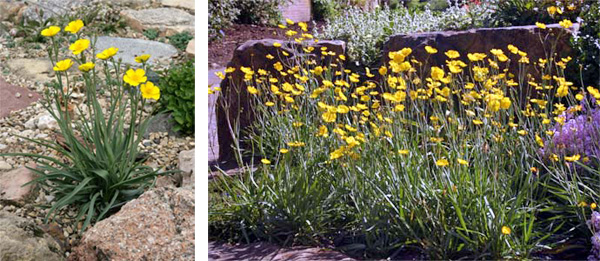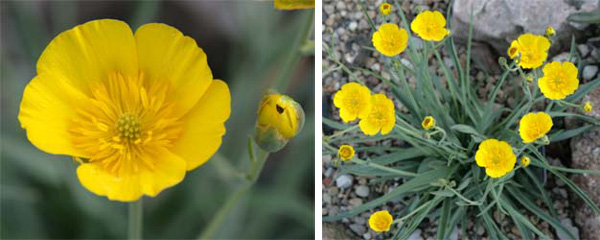The genus Ranunculus – buttercups – is a diverse group with over 400 species of annuals, biennials and perennials from many different habitats that typically have yellow, cup-shaped flowers. One species, only occasionally offered as an ornamental, is R. gramineus, variously listed as grass buttercup, grassy buttercup, grass-leaved buttercup or mountain buttercup. R. gramineus received the Royal Horticulture Society’s Award of Garden Merit in 2005. It is referred to as an alpine or an herbaceous perennial (or sometimes even as a bulb, probably because it behaves like a winter growing bulb, although it is not a bulb). Several references indicate it is hardy only from zones 6 or 7 through 10.

This perennial from well-drained Alpine meadows of southern Europe and North Africa forms clumps with narrow, grass-like leaves. The leaves, up to 8” long, vary in color from gray-green to blue-green. It goes into dormancy in late summer, when the foliage dies back to the ground. In mild climates leaves reappear in the fall. In the Midwest they may regrow when it remains warm late into the season.

In spring and early summer R. gramineus produces a profusion of lemon yellow flowers on slender, erect stems about a foot high. The ¾” wide flowers are solitary or in groups of three.

This small-scale species is useful when space is limited. It is great in the rock garden in a trough or in the front of the border but needs to be placed where the dying foliage in summer will not be an eyesore. It is easy to grow in full sun and well drained soil. It can be propagated by division in the fall or from seed. Sow the fresh, green seed, as soon as it is produced. Self-sown seedlings might be found around the plant. Rabbits may be a problem, but otherwise R. gramineus does not have serious pests.
– Susan Mahr, University of Wisconsin – Madison





 Marigolds
Marigolds Create a Butterfly Garden
Create a Butterfly Garden Plant Flowers to Encourage Beneficial Insects
Plant Flowers to Encourage Beneficial Insects Forcing Bulbs
Forcing Bulbs


